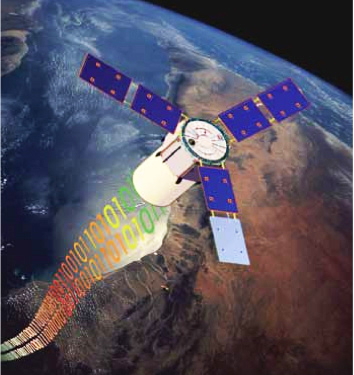
Artist's rendering of TacSat-3 above Earth, with the ARTEMIS hyperspectral imager. Credit: AFRL.
Based on that mission, Raytheon has been notified that the Air Force Space Command will take control of TacSat-3 with the intent to use ARTEMIS in an operational capacity. "The ARTEMIS hyperspectral imager gives military commanders an important new advantage in the asymmetric battlefield," explains Bill Hart, vice president for Raytheon Space Systems. "ARTEMIS can detect various manmade and natural materials, which adds a fundamentally new capability for the DoD."
Unlike visible imagers, hyperspectral sensors capture light across a wide swath of the electromagnetic spectrum, providing unprecedented spectral detail. That spectral information produces a distinct "signature," which can be compared against the spectral signatures of known objects to rapidly identify potential areas of interest. The ARTEMIS hyperspectral imager combines spectral information with geo-location coordinates in an easy-to-read map. This information is then sent directly to troops on the ground in near real time.
TacSat-3 originated as part of the U.S. Department of Defense's operationally responsive space initiative, which seeks to give field commanders flexible, affordable options for obtaining real-time tactical surveillance data from space. Aided by the ORS Office, and led by the Air Force Research Laboratory, the TacSat-3 program was designed to demonstrate the feasibility of developing and launching a military payload within extremely tight schedule and budget constraints. Raytheon is discussing with several government customers opportunities for rapidly deploying additional hyperspectral space sensors. "Based on our experience on TacSat-3, we're ready to build operational hyperspectral systems like ARTEMIS quickly and affordably," says Raytheon's Hart.

